| The Polar Bear |
|
For a number of years, there have been many species that I have always wanted to see, these include: Penguins, Capercaille, Whales, African Wild Dog, and many other iconic species. Indeed like most wildlife photographers it's a long list that contains many of our top wildlife species. But if I had to name just one species that I really wanted to see and photograph, then my number one target would be the Polar Bear. In November 2013, I achieved this during a photographic trip to the small town of Churchill which is situated on the coast of Canada's Hudson Bay. Every November many thousands of these great "Ice Bears" congregate on the vast tundra near Churchill in what is known as "Polar Bear Alley". The bears wait for the temperature to drop to about -50 Deg C. After a few days of this extreme cold, the sea will freeze over and then the bears are gone, they continue their journey North in search of food. |
 |
| Large male Polar Bear walking over a frozen lake towards the sea ice |
 |
| Up close and personal with arguably the greatest predator on earth !!! |
|
During our stay in Churchill, we had several days local to the town where we saw and photographed both Arctic and Red Foxes, during this time we got some great images. But my highlight was the days spent on the famous Tundra Buggies where we saw a total of about 20 bears. About half of our bear sightings were at a distance, but some were close and allowed us some great photographic opportunities. It is fantastic to sit in the buggy watching a bear at a distance of about a mile slowly walking towards you over the frozen tundra watching and photographing as it gets nearer and nearer. On occasions the bears come right up to the buggy, and although you are too high for them to touch you, they can be as little as eight feet away. |
 |
 |
 |
 |
| We were fortunate enough to see a reasonable mix of polar bear behaviour from lone males patrolling the area through to mothers and young cubs. The whole trip was undoubtedly a fantastic wildlife experience, just like the great BBC wildlife documentaries "Frozen Planet" and "Life In The Freezer". |
 |
|
The Polar Bear is found in five countries: Canada, USA (the state of Alaska), Norway (Svalbard), Russia, and Greenland (which is technically part of Denmark). These countries form quite a large circle when drawn on the map across the high Arctic region but they all have a coastal border onto the frozen sea which allows the bears to spend time on land during the summer and then move away in search of seals as soon as the ice allows. They are one of the biggest predators on earth, the males can weigh up to 700 kg (1500 pounds) whilst the females weigh about half the size of a male, but they eat a lot before going into hibernation and give birth period. During this eating phase they can put on as much as 200 kg. Polar Bears will eat anything they can, including clams and other seafood. But their main diet is Ring Seals and Bearded Seal. One of the main reasons they congregate on the tundra at the side of the Hudson bay is because the seals are found further north and as soon as the sea freezes they can go hunting the seals after so many months without food. A large Polar Bear male is a huge sight. They are fully grown after about 12 years, but will continue to put on weight and bulk if they get enough food once fully grown. These males can live to about 20 to 25 years in the wild and grow to about 8 feet long. When full stretched standing up they are over 11 feet tall. It is hard to know the exact world population of Polar Bears, but it is thought that there are about 25,000 left in the wild. Of these about 65 - 70% are thought to be in Canada. Polar bears generally have one or two cubs and 50% of these don't live to one year old. But those that do live past their first birthday have a high chance of survival into adulthood. Hunting has been outlawed in 1993 except for regulated hunting but local indigenous groups. This now leaves the main threat to Polar Bears as loss of habitat. More on this major issue further down this entry. |
 |
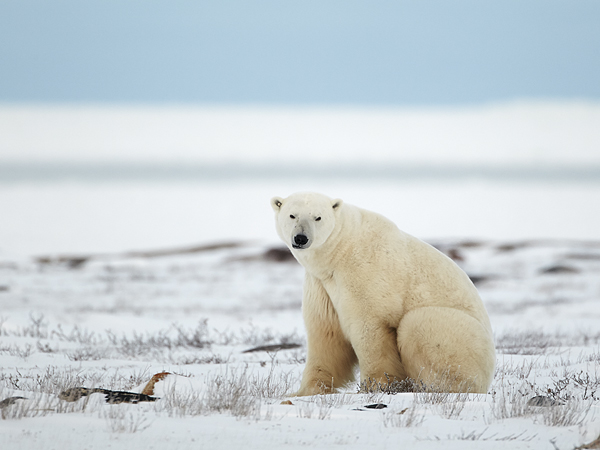 |
| Another large male, about 10 years old |
|
During one encounter we watched a Polar Bear mum and her young cub. The cub was playing with some willow saplings and we had some great views, a few yards from us the wildlife conservation charity Polar Bear International were filming the same two bears that we were watching. When I got home, I located the clip of the actual cub we were all watching. It can be seen on You Tube here. The cub is a young male which is about eight months old. It was nicknamed "willow" by Polar Bears International because of his liking to the willow saplings. |
 |
 |
 |
 |
 |
 |
|
Occasionally, a Polar Bear would come up close to the buggy, this allows a couple of options. Either change to a wider lens with a smaller focal distance, or focus in close to get some portraits. As I like to get some close portraits, I chose to continue using the long lens, but the bears continued to walk towards the tundra buggy, therefore I switched to my shorter 70 - 300 mm lens and the bears continued to fill the frame. |
 |
 |
 |
| The above portraits are from a female Polar Bear aged about six |
|
The vast majority of Polar Bears will not have eaten for many months since they returned south in the spring as the sea ice melted. Indeed the reason the bears are all congregating in the area around Churchill is because this area of the Hudson Bay freezes first and they can then continue their journey north in search of food at the first opportunity. The main food of the bears are the seals found further north, they hunt both Ring Seals and Bearded Seals. But this is all dependant on the cold and whilst they are waiting for the temperature to drop and the ice to freeze, they are grateful for any food that can be found along the shore. Bears will dig for any food they can find including clams in the frozen seaweed. |
 |
 |
 |
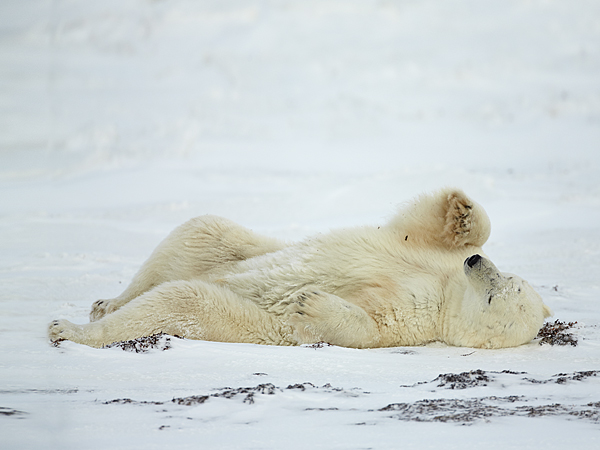 |
|
After the bears emerge from their dens, they haven't eaten for many months, and it is often a few more months before the sea is frozen enough for them to travel north. Therefore, during this time bears will eat anything that they can find which is why they are so dangerous around the town of Churchill itself. In the past they have been well documented cases and TV documentaries of the bears searching on the Churchill rubbish dump eating anything they can find. Times have moved on, and the rubbish dump has been removed, there is now a more rigorous waste management policies are enforced. But the bears still come looking for food. The Polar Bear is a huge draw for Churchill and makes a significant contribution to the towns economic fortunes, but It is obviously dangerous to have bears roaming the streets of the town. As such the local authorities spend quite a bit of time with an early warning siren if the bears stray to close to the town, they also try to scare them off with helicopters but a number still persist in coming back into town. Those that still keep coming back to town will sooner or later find themselves as guests of the worlds only "Polar Bear Prison". It is important not to feed the bears whilst in prison, and there rations are a few shovel fulls of fresh snow each week. when the Hudson Bay freezes they then get transferred North many miles away from danger to either themselves or to the residents and visitors to Churchill. |
 |
 |
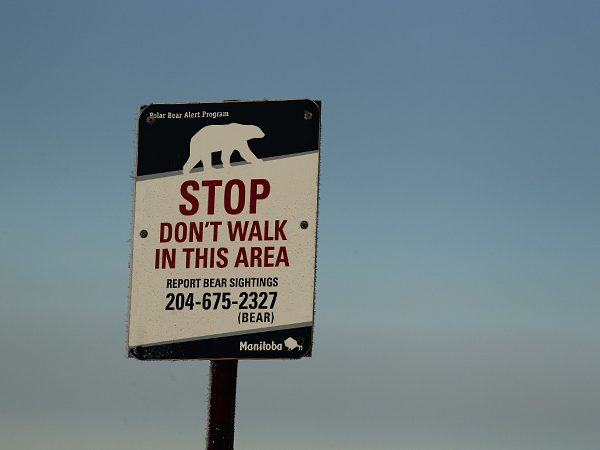 |
|
Churchill is a great place to visit for viewing and photographing Polar bears. It is a small town with a population of about 900 people on the southern edge of the Hudson bay. It is only reachable by boat (during the summer months when the sea is still open), by train (which is a two day 1100 mile train ride from Winnipeg) or by air (also from Winnipeg). It lies in the heart of the Canadian tundra belt which is part of the huge wilderness which covers the high arctic. The tundra covers the northern most area of all five countries across the polar bear range and is almost 4.5 million square miles in size. the tundra is defined as the area where tree growth is hindered due to both low temperatures and a short growing season. This huge wilderness covers mile after mile and is so big it can not easily be appreciated, the high arctic tundra covers a land area of approximately double the size of Australia. When we flew from Winnipeg to Churchill, the tundra extends as far as the eye can see in every direction, yet we covered almost 1100 miles in a flight of over two hours which covered far less than 0.001% of the tundra. Churchill is just south of the Arctic circle and is part of the huge Wapusk National park, This park is 4,430 sq miles in size and is the largest known polar bear maternity denning area in the world. It is also famous for Beluga whales, and many other arctic species. It is easy to imagine the tundra as a large area of frozen grass and nothing else. But despite the low temperatures and slow tree growth, there is still a fair bit of vegetation that is tall enough to be classed as boreal forest which varies from dense forests through to small willow saplings. During our visit we found this lovely large male in a small area of woodland only a mile or so from the coast line of the Hudson Bay. |
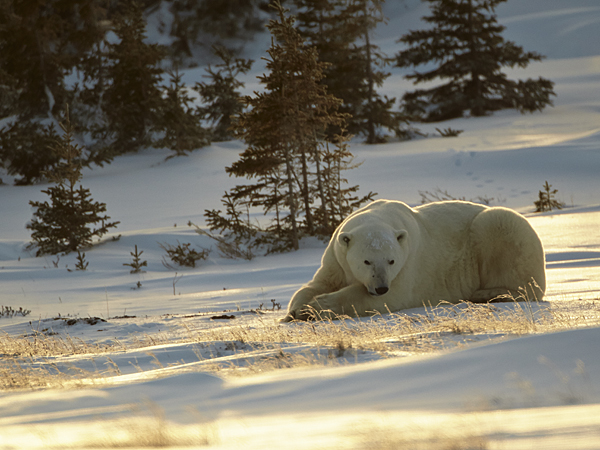 |
 |
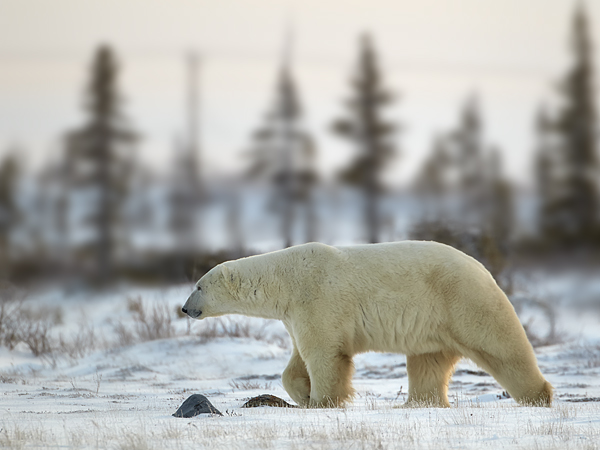 |
|
During our visit, we also had the opportunity to photograph both Red and Arctic foxes, and I can certainly recommend Churchill as a great wildlife venue. Having spent many weeks in Finland and the very far north of Northern Norway in winter, I am used to cold weather photography, but even so, Churchill is not a place for sun worshipers. We encountered a wide variety of weather with temperatures below freezing virtually the whole time. We had some lovely sunny days, but on the warm days it was still minus 25 Deg Centigrade. This quickly falls to minus 35 degrees within a few minutes when the sun disappears behind a cloud. We had almost blizzard conditions on our last day on the tundra buggy, and it was hard work standing on the balcony at the back of the buggy photographing Willow Grouse. We did see polar Bears whilst driving from the town of Churchill to the tundra buggy launch site, but we did not see any in the town of Churchill itself. One evening the warning siren sounded in the town just as we were going to bed. But there again who would be out wandering the streets at night when the temperature drops to minus 55 when the wind chill is taken into account..... |
 |
 |
 |
 |
|
From a wildlife photography point of view, everyone wants to see and photograph polar bears in a variety of locations including on the tundra, with young cubs, and adrift on frozen ice in lovely blue seas and blue skies. As images of the bears adrift on the ice is probably most likely to be achieved on a visit to Svalbard, it will surprise no-one to know that a visit to Svalbard is also very high on my photographic wish list. |
 |
 |
|
Without any doubt, I had a great time in the Canadian Arctic. My visit was brilliant. The chance to view and photograph Polar Bears in their natural habitat was as good as I had always thought that it would be. Indeed, I hope everyone reading this will agree that seeing Polar Bears in the wild is one of the worlds great wildlife experiences. As such if you are considering visiting the bears, then "go for it".
BUT THERE IS ALSO A MAJOR PROBLEM - The polar ice is melting, and Polar Bears need the frozen north as their home. As a species they are on the edge of extinction due to loss of habitat, EVERYTHING MUST BE DONE to ensure the frozen wilderness remains for them and all of the other species that rely on the vast area. Whilst in Churchill we saw first hand the work of Polar Bear International. they do a lot to promote educational awareness of the issues and it is vital that they succeed in protecting the home of one of the habitat so one of the worlds greatest mammals has a long future and a place to call home. From my point of view, I would like to think that many other people can go and witness the cold whilst viewing the bears and taking their own images. Indeed I would love to visit the bears again, it is so much fun. |
 |
 |
|
During the visit I took thousands of shots and these 35 images represent just a very small selection from my time on the tundra photographing one of the greatest predators on earth. |
